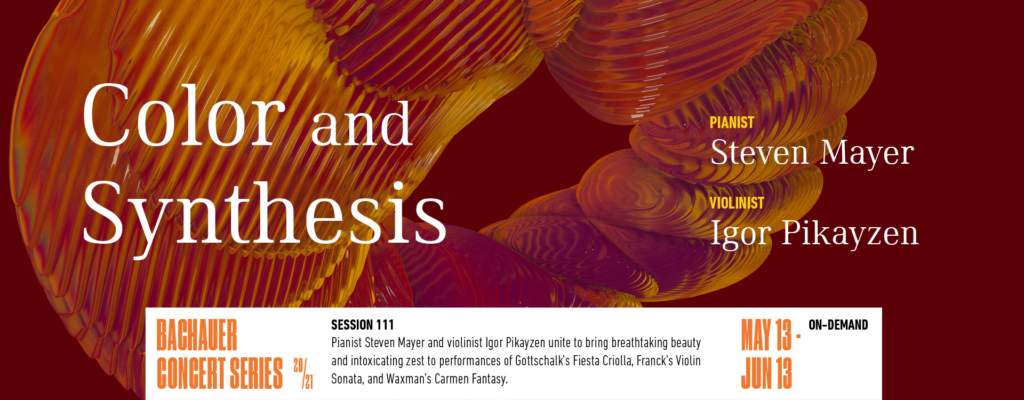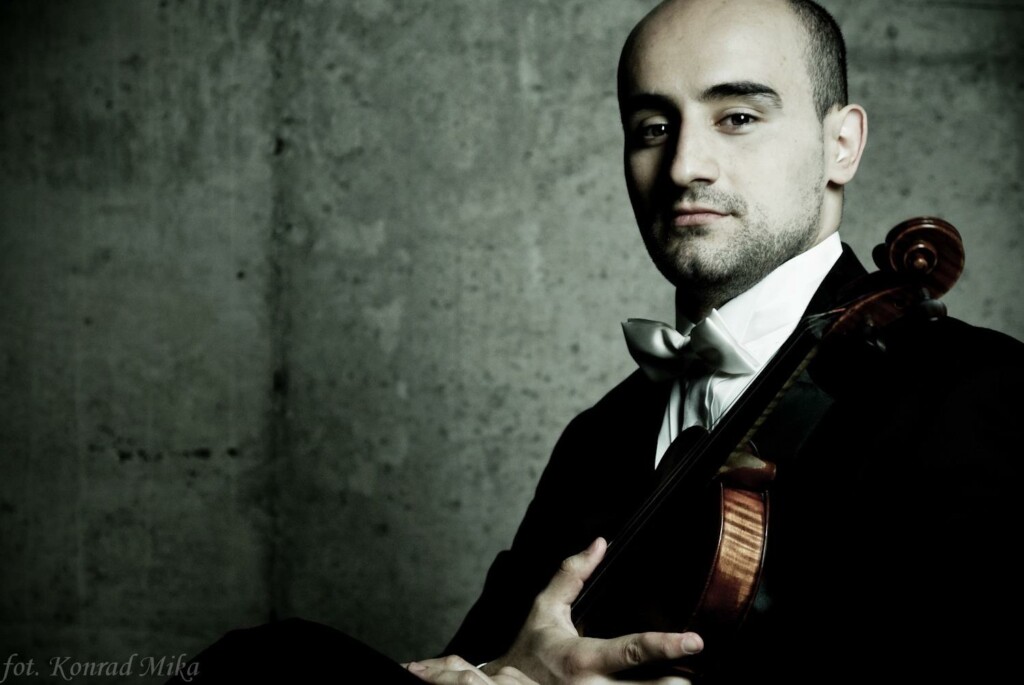Pick a short program of music to celebrate the effusive spirit of spring in May and it would be hard to top the combination of a rousing mix of Latin tropical dance rhythms, the pyrotechnics of an adaptation of Bizet’s Carmen and a violin sonata composed as a wedding gift.
The Gina Bachauer International Piano Foundation’s video-on-demand series of spring concerts concludes with tomorrow’s (May 13) 7:30 p.m. launch of this program titled Color and Synthesis, featuring pianist Steven Mayer and violinist Igor Pikayzen. Both musicians will participate in a post-concert Q&A tomorrow and the concert will be available on demand, with purchased tickets, through June 13.
One of the works is Mayer’s transcription for solo piano of Fiesta Criolla from Louis Moreau Gottschalk’s Symphonie Romantique: Noche en los Tropicos (Night in the Tropics). Recognized as one of the first great American-born pianists, Gottschalk introduced many Latin American musical influences in his works, including the featured selection which was composed originally for orchestra in 1859.
Mayer distills all of the colorful elements in Fiesta Criolla, including the Latin percussion rhythms which drive the Bamboula, an African dance which resembles the samba. Having already completed and recorded his own transcription of the first movement of Gottschalk’s symphony, he is looking forward to recording this latest transcription of the symphony’s second movement. “So much of Gottschalk’s music was written for piano and what he did write in his first symphony was so beautiful not to have a piano transcription of it,” he explains. Mayer adds that the modern piano’s effects can capture all of the “terrific color” in the Gottschalk symphony, even as Mayer takes the liberty to depart from the original in transcriibing the score.
The other two works feature violin and piano in dynamic contrasts. While many composers have composed their own “fantasies” on Georges Bizet’s opera Carmen for violin, Franz Waxman’s 1946 version for violin and orchestra easily is the most definitive and widely performed. For this concert, Mayer and Pikayzen play the transcribed version for violin and piano.
Waxman, one of the greatest composers for film, set the piece for the Warner Bros. film Humoresque, directed by Jean Negulesco, in which John Garfield “played” on screen, his movements synchronized to Isaac Stern’s recording of the work. Later, Jascha Heifetz asked Waxman to expand the work, and his recording is still available today. A remarkable side story from the Cold War era involves David Oistrakh, the Russian violinist, who gave Leonid Kogan, one of his students, the Heifetz recording. As it was impossible to procure a copy of the Waxman version at the time, Kogan copied the notes from the recording to make the score. Later, Waxman, who was touring the Soviet Union as conductor of that country’s orchestras, gave Kogan the score and many of the violinist’s students learned the work. The Waxman version is one of the most widely transcribed pieces for all sorts of instruments and ensembles, including violin and piano.
César Franck, at the age of 64 in 1886, had yet to achieve a wide reputation as a composer but many younger musicians genuinely appreciated his works, which finally are earning their due. One of those musicians include Eugène Ysaÿe, the Belgian violinist. Franck composed the Sonata in A Major for Violin and Piano as a wedding present for Ysaÿe, who made the work a standard in his recital repertoire throughout his long career. All four movements spring from a single motif and the music is wonderfully integrated throughout every section. The first movement (Allegretto ben moderato) functions as a prologue to the second movement (Allegro), while the third (Recitativo-Fantasia) rides a free-wheeling wave. In the final movement (Allegretto poco mosso), Franck tweaks the conventional rondo structure which sets the refrain’s theme as a canon of the octave.
This Franck sonata is music in a pure form without having to rely on the violin’s full range of instrumental effects. For example, the only four-note chord appears in the third movement and a handful of trills are sprinkled in the sonata’s inner movements. But, for the violinist, the piece requires a total control of energy and stamina in achieving the long smooth lines of lush, stable tone color. Ysaÿe often remarked that the only way to play the sonata was con amore, remembering that it was Franck’s wedding gift to him. Pikayzen says that it is a “luxury to have such a great collaborator [Mayer] for such an important piece in the violin sonata repertoire.” In fact, he adds that the piece is more a sonata for piano and violin than vice versa.
Their collaboration is not merely incidental. The Bachauer performance is their second together and they look forward to other collaborations, as live performances return to the halls. Both musicians have distinguished musicians in their family roots and are colleagues at the University of Denver’s Lamont School of Music. Mayer, the son of American composer William Mayer, has not only performed and recorded the classical piano repertoire but also has gained critical acclaim for his performances of jazz music by Art Tatum, Jelly Roll Morton, James P. Johnson and Fats Waller. He won the bronze medal at the 1978 Bachauer competition. He says that it was a high school soccer coach in the Bronx who introduced him to jazz piano music. “I was quickly hooked and 15 years I started playing the music,” Mayer adds.
Pikayzen, a native of Russia, is the grandson of Viktor Pikayzen, who was a legend of the Russian violin school and studied with Oistrakh. His mother also was a classical pianist. The younger Pikayzen made his debut at the age of 8 with the Moscow Philharmonic Orchestra, which launched a career of worldwide performances and top prizes at international competitions. An advocate for a deep, far range of periods and styles, he also launched the Edelio music festival in Westport, Connecticut. Pikayzen, who has just completed the second year as a Lamont School faculty member, is thrilled to be a colleague of Mayer. “I was so surprised that an American pianist knew so much about the Russian and Soviet musical pedigree, especially pianists who were barely known outside of my country,” Pikayzen says.

As teachers, both agree that the pandemic did engender an unexpected silver lining. “My students are playing much better,” Mayer says, adding, “they didn’t have much to do except practice and my students did find it within themselves to go deeper into the musical scores.” Likewise, Pikayzen adds that it was a good opportunity to focus on music outside of the “rat race” of rushing to rehearsals and concerts from one hall to another. “In Russia, we have a saying that the best tasting grapes come from the harshest soil,” he says in explaining the positive takeaways from the long shutdown in the arts.
The concert was filmed on the Jeanné Wagner stage of the Rose Wagner Center for Performing Arts by Wonderstone Films, with sound engineering by Robert Abeyta. Tickets for the concerts are 50% off the normal prices. Tickets can be purchased from Bachauer and for more details visit the Foundation’s website.


